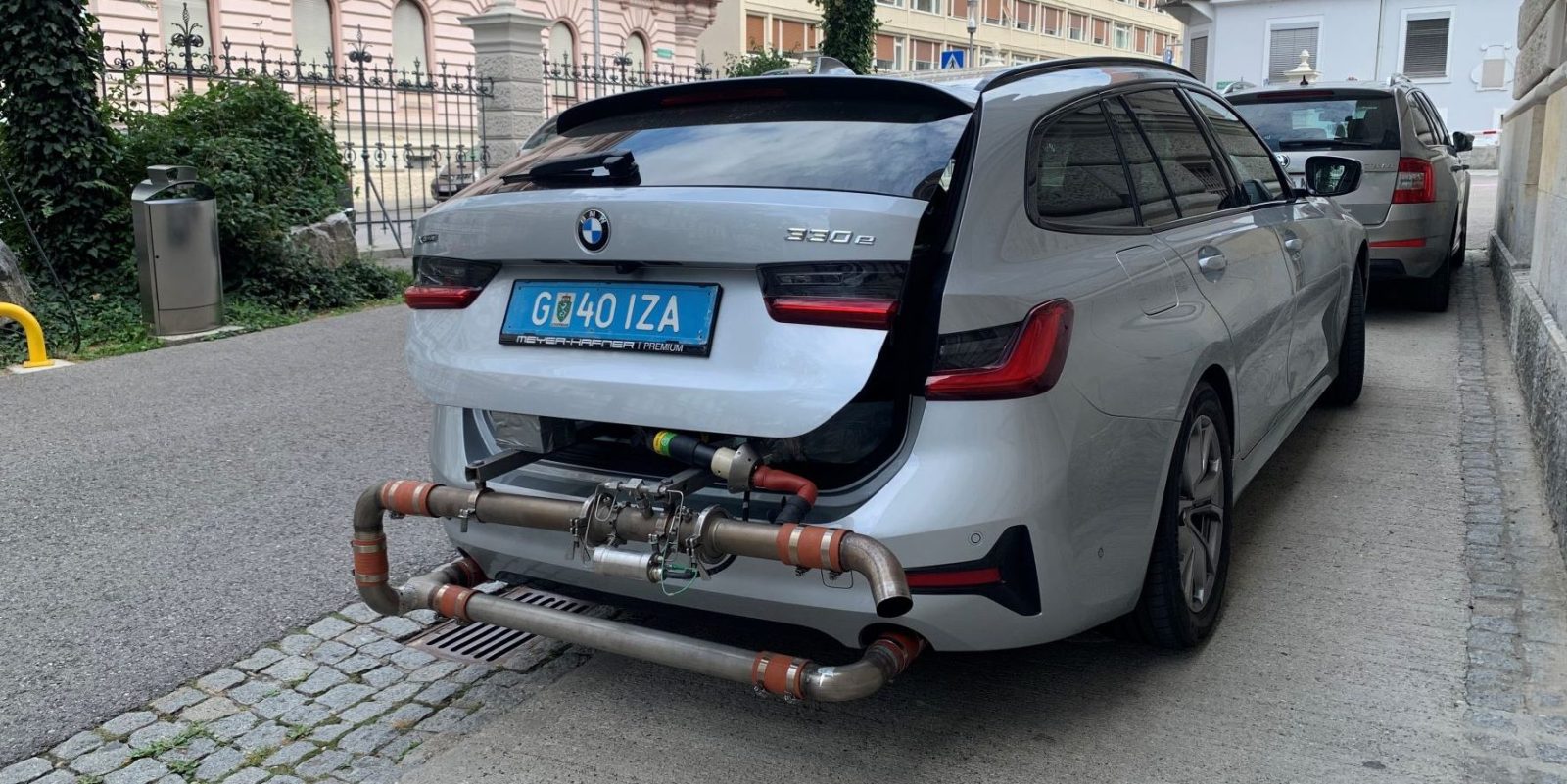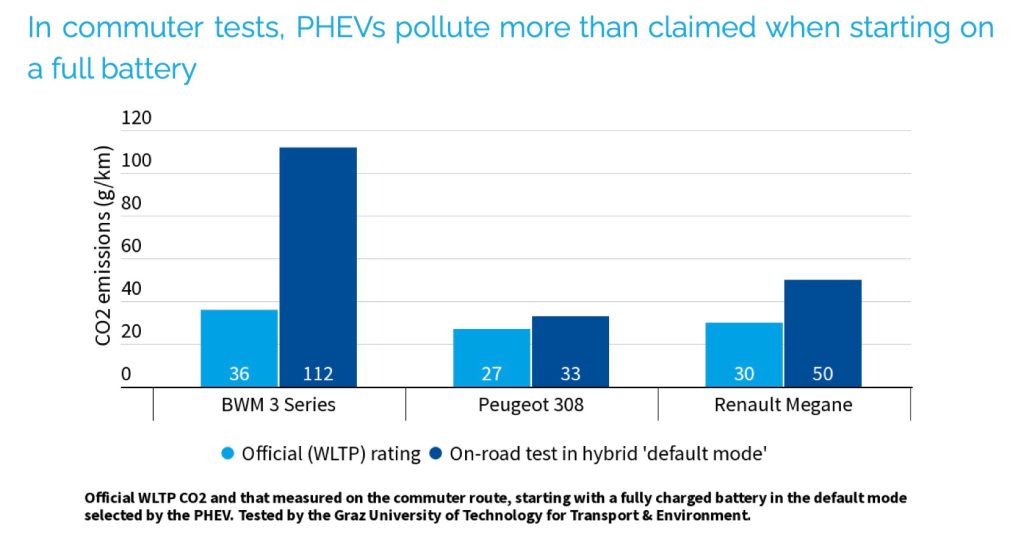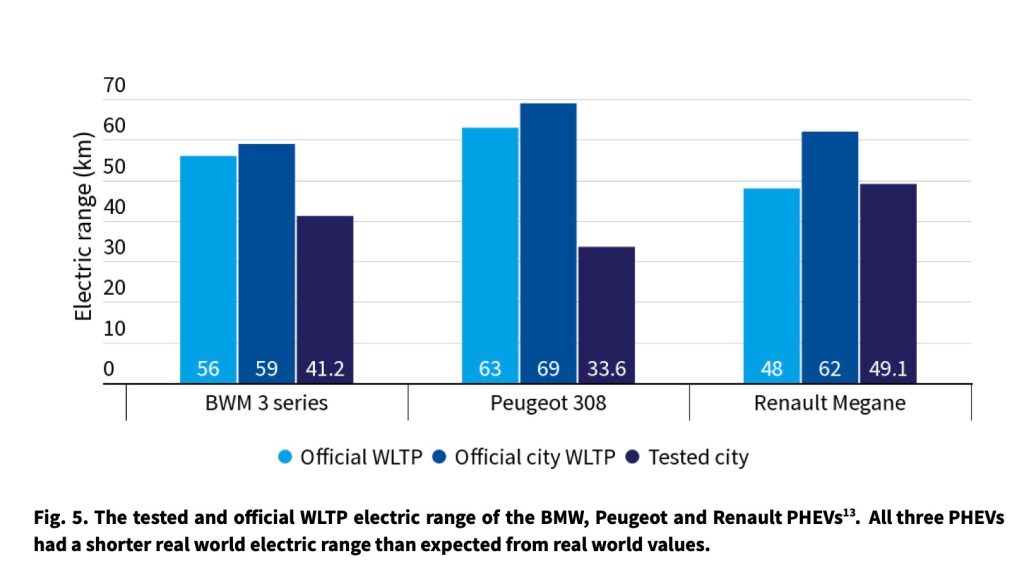
Plug-in hybrids pollute up to three times more than advertised, even when fully charged, and emit five to seven times as much CO2 when the engine is running, according to a new study commissioned by Belgian NGO Transport & Environment and conducted by the University of Technology in Graz, Austria.
The study measured emissions from three popular models: the BMW 3 series, Peugeot 308, and Renault Megane. Like many plug-in hybrids, these cars started as gas/diesel-powered models and then a battery was added on to improve emissions testing performance and mileage.
Each of the vehicles were tested in real-world situations, replicating city driving, commuting, and extended commuting scenarios in and around Graz, Austria. In all of the tests, the cars performed worse than official WLTP ratings would indicate.
In a few of the tests, the Peugeot and Renault occasionally performed close to WLTP ratings – within about 20%. But the BMW, in all tests, fared much worse.

In recent years, many European city centers have started cracking down on pollution and announcing bans on combustion vehicle transport within the most densely populated areas. This has led carmakers to introduce geofenced “electric-only” modes, which automatically turn on in areas where combustion engine use is restricted.
T&E tested the cars in their all-electric modes as well and found them lacking. Not only did all three cars have less pure-electric city range than WLTP testing indicates, but BMW’s geofenced “eDrive Zone” mode failed to guarantee emissions free city driving, with the engine turning on twice during testing.

Many plug-in hybrids have “battery conservation” engine-only modes, which allow a driver to switch on the engine manually in order to charge the battery to ensure reserve charge for when they get to their destination, whether that be a city center or some other location the driver wishes to drive emissions-free. T&E’s testing found that, when in “battery conservation” mode, all three cars had dramatically higher emissions, five to seven times as high as WLTP averages suggest.

Because official tests underestimate emissions, each automaker’s fleet average emissions are dragged down by these unrealistic estimates. This results in financial benefits for the automakers as they can avoid fines for high pollution. T&E estimates that these financial benefits measure in the thousands per PHEV sold: 6,900 euros for Renault; 8,200 euros for BMW; and 9,300 euros for Peugeot (Stellantis).
Or put another way, if PHEV emissions were properly accounted for, automakers would have to sell an additional 247,000 fully-electric vehicles in Europe to bring their fleet emissions down to the level it is currently at. In this way, PHEVs are actually harming BEV sales by allowing automakers to get away with high emissions.

On top of these compliance benefits of thousands of euros per vehicle, PHEVs have also received 350 million euros in direct subsidies across Europe in 2022. A majority of these subsidies came in Germany, where PHEVs leased as company cars are given tremendous benefits but are often treated as gas cars and never plugged in, exacerbating the problem of high PHEV emissions.
This is not the first time T&E has done a similar study. In 2020, it commissioned another test on the BMW X5, Volvo XC90 and Mitsubishi Outlander, all of which, again, polluted much more than official testing suggests.
And T&E’s results echo previous studies by the ICCT, the group which first blew the whistle on Volkswagen’s dieselgate scandal. These studies found that both in the US and Europe, PHEVs use much more fuel than government labeling claims, with only the BMW i3
T&E ended their findings with policy recommendations for governments to better account for real-world emissions from PHEVs, which looked relatively similar to ICCT’s recommendations from their previous study. Here are T&E’s key recommendations:
- PHEVs should not be treated as zero emission even if they have geo-fencing capability.
- PHEV ownership and company car benefit-in-kind taxation should be based on the actual CO2 reduction delivered by individual PHEVs in the real world.
- Privately owned PHEVs should not receive purchase subsidies. Where these exist (e.g. in early BEV markets), they should be based on performance criteria, such as: a minimum electric range of 80km, the power of electric motor at least equal to the power of the ICE, capability to fast charge and maximum engine only CO2 of 139 g/km.
- No purchase subsidies should be given to company cars.
- Official PHEV CO2 emissions need to be regularly updated with real world data.
- The option to charge the PHEV using the internal combustion engine should be removed by carmakers.
- Carmakers should educate and reward PHEV drivers for driving electrically.
Toyota’s chief scientist Gill Pratt recently made some headlines by suggesting that the world would benefit more from hybridizing transportation rather than electrifying it. This claim was dismantled by Auke Hoekstra, a researcher from Eindhoven Technical University who spends much of his time debunking EV myths. But studies like this, showing that hybrids pollute more than we thought, suggest that Toyota’s estimates may need some modification.
Electrek’s Take
PHEVs are an attractive solution for automakers and drivers because they represent a middle-ground which allows for emissions reductions but doesn’t require nearly as many manufacturing or habitual changes from those respective groups.
And they surely reduce emissions as compared to gas- or diesel-only cars when used correctly. Plus, when battery supplies are thin, it’s attractive to think that electrifying three cars with 20kWh batteries might result in better emissions reductions than one car with a 60kWh battery.
But the problem is that PHEVs often aren’t used correctly, as in the case of Germany’s company car leases, or small-battery PHEVs like the Plug-In Prius which many drivers only buy to get access to incentives like carpool stickers or tax rebates.
Top comment by Great Success
Seems like the conclusion of this study is that vehicles are less efficient than their WLTP numbers indicate. Which is pretty much standard knowledge for anyone who follows this stuff. I'm not disputing that hybrids are less efficient than everyone thinks, but if we want to understand the true performance of any vehicle, don't use WLTP. Almost feels a little click-baity, like they came up with a study designed to make hybrids look bad. To truly capture their impact, you have to index the results to how EVs and ICE cars perform relative to WLTP, and I didn't see that in this writeup.
In addition, even when used correctly, research shows that government emissions estimates are too low, both in the US and Europe. This allows manufacturers to get away with polluting more by selling more-polluting gas cars and our whole society gets less healthy as a result.
Further, PHEVs mean a continued revenue stream for the fossil fuel industry, which is the group that got us into this whole mess in the first place.
So while we understand that well-designed PHEVs like the BMW i3 can be used correctly – and better-designed PHEVs will be more likely to be used correctly, as both ICCT and T&E’s recommendations point out – it still seems apparent that BEVs are the better choice. Even in the current battery-constrained environment, and with consumers who often ask for far more range than they need, any calculation of relative PHEV and BEV emissions reductions must take into account not just laboratory testing, but real-world numbers.
All this put together suggests: BEVs are the way to go, but any PHEVs we do produce should be designed as electric-first, with a small gas engine only used as a backup.
FTC: We use income earning auto affiliate links. More.





Comments